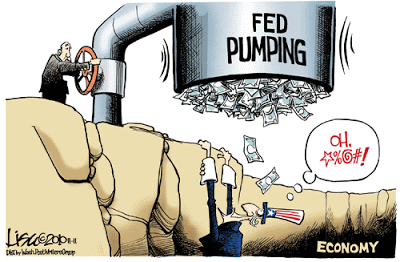There are many ways on how to value a company using the different methodology school of thoughts.
I had previously wrote an article about two of the methodology which you can view over here. One of the valuation methodology, Discounted Cash Flow (DCF) is one of the most commonly used across investors for many reasons.

The recent monetary policy of heavy quantitative easing done across the globe seems to suggest that we are on a decade long of low interest rate where it allows stimulation of funds chasing around after riskier assets, such as equity and housing.
In general, the objective of the easing of monetary policy and reduction of the banks’ reserved rate is to allow banks to lend more money to companies so they are able to fund the loan at cheaper rate and expand to grow at a faster rate than if there were no easing on the policy.
These popular monetary easing policy has resulted in a euphoria spike in interests for both the investors and media pundit and it has helped to push the share price of many stock markets to its high despite the problems ahead. Just take a look at where the US market is heading today and you will understand my point.
As a result of such phenomenon, this usually poses a problem to investors when they are trying to simulate DCF and project earnings or cash flow across the next 5 years or more.
One. The discount factor would be affected because as interest rate gradually rises, the proportion that is financed by debt would increase as the cost of debt becomes more expensive. This means that the discount rate would have to increase over time and using a standard discount rate across can be deceptive to an investor at best, especially if this is extrapolated over longer number of years.

Second. The growth (g) factor would also need to be adjusted conservatively downwards with everything else equal once the policy is back to normal. What this means is if you are expecting to project a company to grow at 10% during periods of easy monetary policy, then you should expect earnings growth to be lower once things are back to the normal. By standardizing the growth over the next 10 years and extrapolating them over time, it will create a false sense of guide and misguide the fair value perception for the investor.
The quantitative easing will come to an end sooner or later. The US is already showing signs that the Fed will be raising interest rate hike by a couple of percentage point this year. When they do, investors will need to be mentally prepared because this will have an impact on the valuation of the company, especially if you aggressively value your company at the beginning.


That's why I prefer using value investing method or even my own method – the triple S Scorecard method.
Hi TUB
To be fair, all method has their limitations. But all so far so good for your triple Scorecard method 😉
The discount factor is why I am worried over REITS here. They are using historically low discount factors to justify asset values. Moment these rates goes up, asset values will decrease, therefore increasing their leverage ratio. After which, they have to do euity raising to reduce leverage
Hi Choon Yuan
Yes, absolutely agree with you.
It is hence critical for investors not to assume that everything that is being discounted to their NAV is a good buy right now. There are a lot of factors which has not been taken into account just yet.
QE has already ended in 2014. Mistake by blogger in the last para of the post.
Thanks for pointing out.
eToro is the most recommended forex broker for rookie and professional traders.